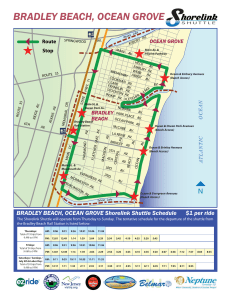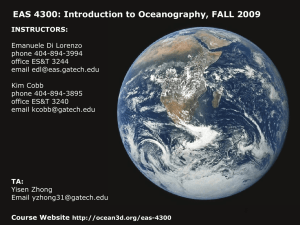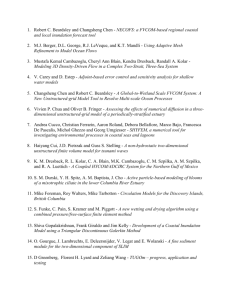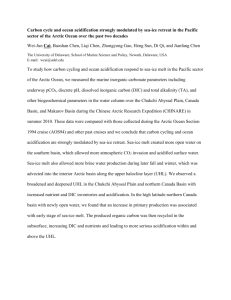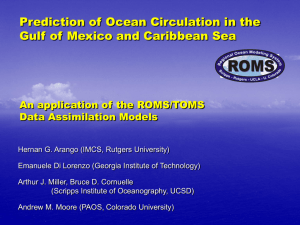Mean zonal geostrophic velocity at the ocean surface, high
advertisement
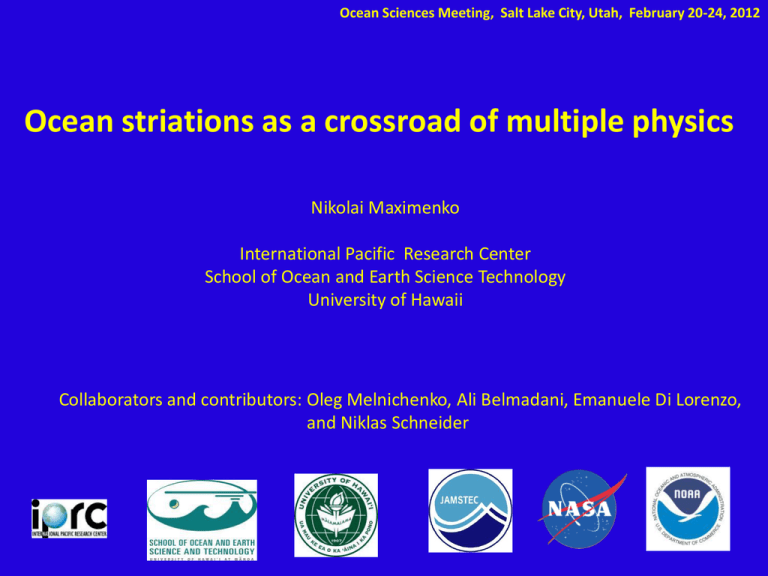
Ocean Sciences Meeting, Salt Lake City, Utah, February 20-24, 2012 Ocean striations as a crossroad of multiple physics Nikolai Maximenko International Pacific Research Center School of Ocean and Earth Science Technology University of Hawaii Collaborators and contributors: Oleg Melnichenko, Ali Belmadani, Emanuele Di Lorenzo, and Niklas Schneider Striations cm/s in long-time mean zonal geostrophic velocity at the ocean surface, high-pass filtered horizontally with two-dimensional 4° filter. Smearing of eddy signal by time averaging Schlax and Chelton, (2008) – Figure 2 Maximenko et al. (2005) Scott et al. (2008) cm/s Many striations seem to dynamically correspond to betaplumes, induced by local vorticity forcing at their eastern tips cm/s Mean zonal geostrophic velocity at the ocean surface, high-pass filtered horizontally with two-dimensional 4° filter. Azores current Kida, PhD: Azores current is a beta-plume induced by overflow of Mediterranean water into Atlantic Mean zonal geostrophic velocity at the ocean surface, high-pass filtered horizontally with two-dimensional 4° filter. cm/s Jets off California coast Centurioni et al, 2008: beta-plume induced by interaction between mean Ekman flow and stationary meanders cm/s Mean zonal geostrophic velocity at the ocean surface, high-pass filtered horizontally with two-dimensional 4° filter. HLCC: curl-driven zonal jet (slide courtesy of Belmadani) Ekman flow: w Chavanne et al. 2002, CJRS Sverdrup flow: V v f w 1 z z Sverdrup Vorticity Equation w Vorticity produced by vertical stretching + fluid turbulent stress. f Vorticity increased by moving poleward. Ekman pumping Curl drives Ekman pumping / suction. V Thermocline is lifted / depressed. Cyclonic / anticyclonic eddies (e.g., Calil et al. 2008, DSR). Rossby waves propagate anomalies (e.g., Sasaki et al. 2010, OD). Sverdrup Balance Meridional transport driven by curl. Volume conservation: U U V 0 x y Barotropic Continuity Equation Nondivergent barotropic flow. Zonal transport to the west. V dx xe y U x Integration from eastern boundary HLCC: wind-forced β-plume (slide courtesy of Belmadani) ← Rossby waves Western boundary Cyclonic eddies Curl > 0 V>0 Qiu et al. 1997, JPO HLC Island Anticyclonic eddies HLCC NEC Curl < 0 V<0 Elongated double-gyre west of Hawaii. HLCC: narrow eastward jet embedded in broad North Equatorial Current (NEC). β-plume (Rhines 1994, Chaos) = Sverdrup gyre driven by compact vorticity source (momentum, heat, mass). HLCC = wind-forced β-plume (Jia et al. 2011, JGR). Other mechanisms: air-sea coupling, islandinduced modified large-scale flow (Qiu Durland 2002, JPO), mode water intrusions (Sasaki et al. 2012, JO), etc. Xie et al. 2001, Science Spatial-filtered SST & wind HLCC advects warm SST → far-field curl dipole (Xie et al. 2001, Science; Hafner Xie 2003, JAS; Sakamoto et al. 2004, GRL; Sasaki Nonaka 2006, GRL, etc.). Linear β-plume: steady-state barotropic solution (slide courtesy of Belmadani) Wind: steady mesoscale anticyclonic vortex τ x max e R y.e x2 y2 2 R2 y max e R x.e x2 y2 2R2 , R = 40 km Meridional transport: Sverdrup balance V ∇ xτ τ , ρ = 1025 kg.L-1 β ≈ 1.98 10-11 s-1m-1 Zonal transport: continuity equation y2 max e 2 R 2 V U dx y.e 3R 2 y 2 4 xe y R 2 x xe 2 x2 xe x 2 2 .erf erf R x.e 2 R xe .e 2 R 2 R 2R Uana Good agreement between analytical and numerical solution. 1 anticyclonic cell (2 jets) + 2 weak cyclonic cells ⇒ 2+2 x-independent zonal jets. , xe ≈ 2890 km ULIN Nonlinear β-plume: eddies and mean flow (slide courtesy of Belmadani) 38ºN 34ºN SLNL 30ºN 26ºN 22ºN 38ºN 34ºN Yr 21 178ºE 178ºW 174ºW 170ºW 166ºW 162ºW 158ºW 154ºW 150ºW SLNL 30ºN 26ºN 22ºN Yr 21-30 178ºE 178ºW 174ºW 170ºW 166ºW 162ºW 158ºW 154ºW 150ºW With stronger forcing, nonlinearities and instabilities grow, mesoscale eddies are shed from the forcing region. Mean circulation is modified and becomes a dipole with 3 jets and a broader y-scale. Heterogeneity of eddy trajectories Schlax and Chelton (2008) – Figure 1 Heterogeneity of eddy trajectories Schlax and Chelton (2008) – Figure 1 Space correlation functions of U’ and ζ’ reveal long zonal correlations and indicate that eddies may be exaggerated and striations may be suppressed during mapping From AVISO data From AVISO mapping function Effect of background meridional flow : advection Linear regime Forcing Nonlinear regime Forcing V0 k=(k,l) Eddies induced by instability of large-scale flow Eddies Induced by instability of striations Induction of eddies by forcing Tilt of striations correlates with the direction of background glow Effect of background meridional flow : instability Spall (2000): Generation of strong mesoscale eddies by weak ocean gyres Stage 1: Instability of meridional flow produces strong zonal jets Stage 2: Instability of zonal jets produces heterogeneous, isotropic eddies. Formation of new eddies is not completely random All eddies New eddies Histogram of anticyclones relative to crests in striations Histogram of cyclones relative to troughs in striations Concluding remarks: 1. Eddies are important (and most energetic) players in visualizing striated patterns. 2. Striations reflect higher organization of eddies (preferred paths, eddy trains, etc.). 3. Understanding striations may be more feasible through dynamical rather than kinematic study. 4. “Anchoring” processes that still need to be understood: - anchoring of source regions to topographic features; - anchoring of new eddy formation to striations; - possible fixation of western tips of striations; - air-sea interaction.
